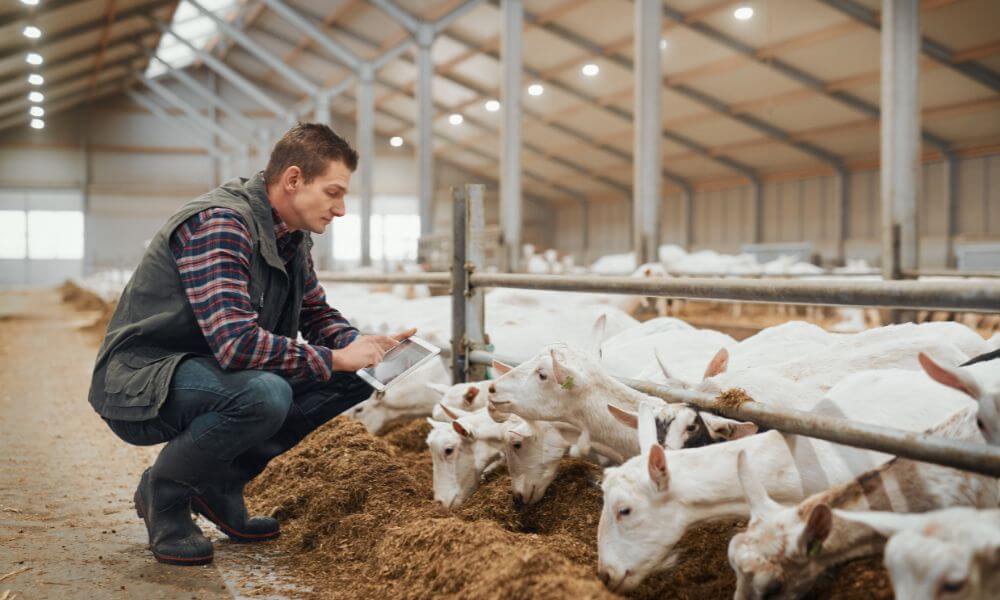If you are reading this then you are probably interested in becoming a goat farmer.
Well. just hold your horses.
Before you up and quit your nine-to-five to start your own farming business, there are a lot of things to consider.
Perhaps the most important question to ask yourself before diving headfirst into a new career as a goat farmer is how much does a goat farmer make?
Read on as we look into this in a bit more detail!

Is goat farming profitable?
Yes, goat farming is profitable!
As long as you effectively manage your cost-to-income ratio, a goat farm of any size can turn a profit.
How much money can you make with goats?
As for exactly how much you can make as a goat farmer, the answer isn’t very simple.
There are a lot of determining factors that play into the final number like goat breed, region, farm size, overhead expenses, herd population, and the kind of final product(s) you intend to sell.
How much does the average goat farmer make?
Overall, the average salary of a goat farmer varies from country to country and even region to region.
Check out the averages for a few of the world’s biggest suppliers of goat products:
| Country | Average salary
(local currency) |
Average salary
(USD conversion) |
| United States | $39,387 | $39,387 |
| United Kingdom | £21,408 | $26,380 |
| India | ₹3,70,360 | $4,739 |
| Pakistan | 776,239 ₨ | $3,810 |
| China | ¥50,401 | $7,512 |
| Canada | $46,641 | $36,490 |
| Iraq | 14,962,355 IQD | $10,182 |
| Mexico | $96,177 | $4,817 |
You can maximize your profit (and in doing so, increase your income) by utilizing some or all of the different streams of income available to a goat farmer.
What are possible streams of income for a goat farmer?
There’s more to goat farming than meat and dairy.
Check out all the different revenue sources available to goat farmers:
Meat
Goat meat is rising in demand in the US thanks to supply chain issues and the soaring costs of other animal proteins like beef, pork, lamb, and chicken.
As long as you’re comfortable with butchering the animals (or hiring someone else to do it), farming goats for meat is a viable business.
Dairy
Dairy can be an especially lucrative source of income for goat farmers since it’s used to make all kinds of products, ranging from cheese and gelato to all-natural skin and hair care.
Farmers can make upwards of $5 per gallon of goat milk (as much as $20 in some regions where supply is low) and the average nanny goat produces 3-5 quarts of milk per day.
Hide
Goat hide or skin can be tanned into leather and used for anything from book covers to rugs and leather apparel.
Goats aren’t often raised for their hide alone.
It’s typically a byproduct of processing the animal for meat.
Related Post: Goat Leather vs Cow Leather (Comparison)
Fiber
Goat-made fibers like cashmere and mohair are popular across the globe.
Angora goats can be shorn twice a year and produce an average of 8 pounds of fiber per goat.
The price per pound varies depending on the quality of the fiber.
Breeding
Breeding and selling goats is highly profitable, as most does (female goats) can produce offspring (also known as kids) twice a year, with some bearing multiple offspring from the same pregnancy.
This practice often goes hand-in-hand with dairy farming, because the does must have kids in order to lactate.
Some breeds of goat are worth more on the market than others, depending on what their purpose is.
Boer goats are widely regarded as the best for meat, but Saanen goats produce more milk than other breeds.
For fiber farms, Angoras are the most desirable.
You can raise and sell more than one breed of goat at a time, of course.
Renting
Did you know that you can rent out your goats to businesses and individuals to aid in land management?
Goats can mow down overgrown brush quickly, easily, and sustainably just by grazing as they normally would on a pasture.
You can charge per goat per day or by acreage.
Education
In addition to making money from producing things like meat, hide, fiber, and dairy, goat farmers can make an additional income by producing goat-related content like tutorials, blogs, videos, and courses to educate others about goats and the work that goes into keeping them.
Tourism
Tourism is another profitable addition to a goat farming business that is often overlooked.
Opening your farm to the public for an admission fee is a great way to make extra income while operating the farm as usual.
At most, you’ll have to hire a few extra farm hands to manage the crowd, but you can go as far as hiring an organizer and event staff to facilitate larger gatherings.
Of course, some of these revenue streams are more profitable than others, but you can combine any (or all!) of these methods to make your goat farming business more efficient.
For example, you can breed goats, sell a few kids, milk the mother goats, harvest fiber as it’s available, rotationally rent a few goats out to clear land, open your farm to tourists, butcher the goats for meat & hide once they’ve no longer become productive, and maintain a profitable Youtube channel, blog, or course throughout the whole process all at once!
Regardless of the purpose that your goats are destined for, all that really matters to turn a profit in the goat farming business is maintaining a healthy cost-to-income ratio.
Fetching a good price for your final product and managing the cost of raising & caring for your goats will provide a sustainable source of income.
If you play your cards right, you’ll be able to earn well above the average annual income of a typical goat farmer.
